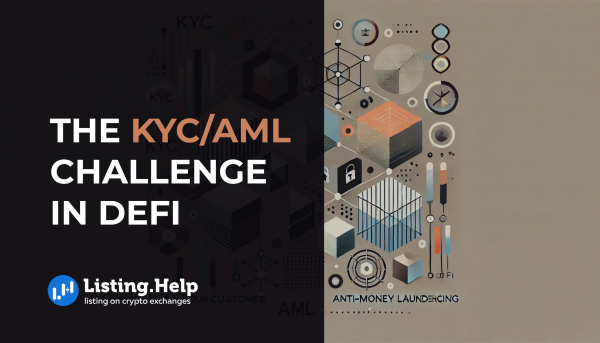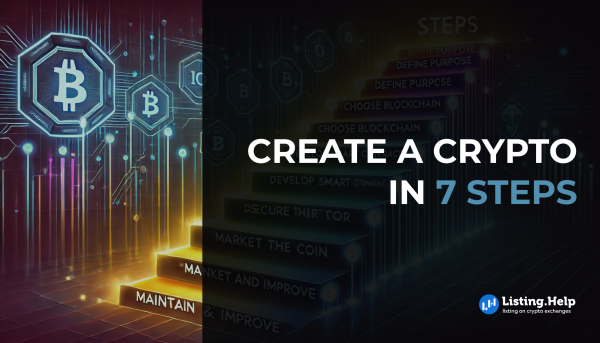How to Create Your Own Cryptocurrency: A Step-by-Step Guide
 November 15, 2024
November 15, 2024 Updated Jan 26 2025, 05:29
Updated Jan 26 2025, 05:29
LEAVE A REQUEST
Launching your own token project? Our experts are ready to help with listing on exchanges, market making, marketing and other solutions
SUBMIT APPLICATIONMany companies and startups are creating their own cryptocurrencies. In doing so, they introduce innovative financial models to their projects and earn tens of millions of dollars from the listing and subsequent growth of the token’s capitalisation. In this guide, we will detail the steps of creating, launching and maintaining a cryptocurrency, from the initial concepts to the practical part. Let’s get started!
What is a Cryptocurrency?
Cryptocurrency is a digital currency based on blockchain technology. The main feature of crypto is its independence from banks and governments, as well as the decentralization of data and the protection of transactions. Unlike traditional currencies, all crypto transactions take place without intermediaries such as banks or regulators. And all transactions are recorded in a database called the blockchain. These features make cryptocurrency transactions more transparent and fraud-proof, as transactions on the blockchain are recorded forever without the ability to change the record. This eliminates the possibility of transactions being tampered with.
Why Create Your Own Cryptocurrency?
Creating your own cryptocurrency helps projects attract investors and loyal users, as well as strengthen your brand. Cryptocurrency can be used to solve specific business problems, such as incentivising the community, creating loyalty programmes or making payments on your own platform. An example would be tokenising different assets or using tokens to access project services. These features give companies financial flexibility and expand their capabilities.
Benefits of a Custom Cryptocurrency
Owning your own cryptocurrency is a powerful tool for creating financial ecosystems. The main benefits of creating your own token include
- Attracting investors and increasing the capitalisation of the project.
- Create and support an active community.
- Raise awareness and strengthen the brand.
- Integration into the decentralized financial space (DeFi).
- Possibility to create a system of rewards and loyalty programmes.
- Increased transparency and trust through the use of blockchain technology.
- Use your token to expand monetisation opportunities, e.g. to pay for the project’s services or goods.
Key Steps in Creating a Cryptocurrency
Step 1: Define Your Goals and Use Cases
Before creating a cryptocurrency, you need to define your goals and target audience. It is important to understand why your cryptocurrency is being created and what problems it will solve. Understanding the audience will give you an idea of what type of social media the project should be run on, how to build a marketing campaign, and who to buy advertising from.
Step 2: Choose the Right Blockchain Platform
But first, you need to decide whether you want to use an existing blockchain such as Ethereum, Solana or Ton to create your token, or create a full-fledged coin that runs on your own blockchain.
Using platforms with pre-built token standards makes the creation process much easier and reduces costs. However, building your own blockchain gives you more flexibility to create a unique system that can be used as a strength of the project.
Step 3: Design the Nodes and Network
If you decide to build your own blockchain, you should realize that nodes are the foundation of the blockchain. The more users running a node, the more stable the network will be. Nodes are often divided into full and light nodes. Full nodes store a large amount of information, often all transactions on the blockchain. Light nodes can only support a subset of transactions and do not store the entire history of the blockchain. However, this saves resources as light nodes can run on weak hardware.
Step 4: Establish Consensus Mechanisms
The next step in creating your own blockchain is to choose a consensus mechanism.
A consensus mechanism is a protocol that ensures that nodes synchronize with each other and agree on which transactions are considered legitimate and can be added to the blockchain.
Currently, the most popular consensus mechanisms are Proof of Work (PoW) and Proof of Stake (PoS). PoW requires significant computing power to operate and is essentially cryptocurrency mining. Miners use their power to verify transactions and are rewarded for doing so.
While the PoS mechanism is more energy efficient and depends on the number of coins inserted by users to generate revenue. This provides users with additional income and the project with a more stable network.
Step 5: Develop Smart Contracts
The creation of a smart contract may be required when choosing an off-the-shelf network and then creating a token on it, as well as in some cases when creating your own blockchain and coin on it.
Smart contracts allow for the automation of operations with the token, ensuring that the terms of transactions are met. When creating a smart contract, a programmer can specify any conditions for fulfillment, from simple transactions to more complex logical schemes, such as adding a feature to automatically transfer tokens, make payments when certain milestones are reached, or credit rewards for user activity.
Step 6: Secure the Network and Test
Security should be considered upfront. This should be done both when creating your own blockchain and when choosing an existing blockchain.
Security is a critical element for all projects. Projects with a high level of security and audits from trusted auditing companies will be seen as more secure by users. This means that you can increase your user base through loyalty.
Before launching a project on the mainnet, both the blockchain itself and the smart contracts should be tested to identify vulnerabilities and potential risks. This is often done by using test networks, which help you verify the stability of the network and avoid potential problems, as well as third party audits, which help you identify and eliminate vulnerabilities before the project is released, thus avoiding potential loss of your funds or users’ funds.
Step 7: Launch and Maintain the Cryptocurrency
Once testing is complete, your cryptocurrency is ready to launch. However, even after launch, it’s important to provide uninterrupted support to users and regularly update your blockchain and introduce new features to follow the market narrative. Most projects continue to develop new features and expand the functionality of their product after launch.
Support and regular updates can ensure the sustainability of the network, attracting new users and setting the project up for long-term success.
Technical Requirements for Creating a Cryptocurrency
Programming Languages and Tools
There are many programming languages available for writing smart contracts. The most common are Solidity for writing smart contracts on Ethereum, Vyper, which is a simplified version of Solidity, and Rust for developing smart contracts on Solana.
Many blockchains have their own programming language, but often blockchains use standard programming languages to attract more developers to their blockchain.
When choosing a blockchain for your project, research which programming language the programmer should write in to understand the workflow and be able to set a task for them.
There are many other tools for working with crypto: frameworks for development and testing, such as Truffle for Ethereum, and platforms on which you can deploy an already written smart contract, such as Remix or Hardhat.
Skills Needed for Cryptocurrency Development
To create a cryptocurrency and fully develop and launch a project, your team will need a variety of skills and knowledge from different areas:
- First and foremost, you need programming and blockchain development skills. You will need to be able to work with the programming language that will be used in your blockchain. Developers also need to be able to write and test code for smart contracts and blockchains. Recently, however, the importance of programming skills in creating your token has become less and less important. Many services have emerged to help you create your own smart token without writing code. However, it should be understood that this will be a standard smart contract without any unique features. If you need such unique features, you will not be able to do without programming skills.
- Cryptography and security is another area of expertise that your development team should know. Knowledge is needed to secure transactions and build privacy in the network.
- Testing and auditing skills will be another link to the success of your project. Developers need to be able to test code and audit smart contracts, which will help avoid vulnerabilities and improve the resilience of the network. Many companies choose to use test networks to refine all the features of a new blockchain, identify bugs and analyse performance. After testing, they deploy the blockchain on the main network. Many projects also use third-party auditors to test the project’s code and point out bugs and potential vulnerabilities.
- And, of course, you need marketing and community management skills. For a project to be successful, it is not enough to create and launch a technically perfect project. It is important to attract and retain an audience. Effective marketing can include developing all available social networks, holding AMA sessions, working with influencers and building partnerships with major crypto platforms. In addition, it is important to create an active community that will embrace the idea of the project and start spreading information about it on their own, thus maintaining the reputation of the cryptocurrency.
Legal and Regulatory Considerations
If you are launching an international project, it is important to realize that each country has its own laws regulating cryptocurrencies. Therefore, it is important to consider a number of issues:
- Comply with AML and KYC regulations.
- Investigate the issue of taxation.
- Some countries may require a license or registration as a financial institution.
- Willingness to report transactions to regulators to prevent illegal activity.
FAQ
How much does it cost to create a cryptocurrency?
The cost of creating a cryptocurrency depends on the complexity of the project and the choice of platform. If you create a token on Solana using a pre-built smart contract, the minimum you can afford is $1,000-$2,000. However, this will only be your initial investment and you will definitely need additional infusions as the project develops.
However, if you choose to create a blockchain or smart contract on your own and have a team of developers, marketers and other key employees, the development of such a project can take many months and cost millions of dollars.
How long does it take to create a cryptocurrency?
Creating a cryptocurrency can take anywhere from a few weeks to a few months. Most projects are created within this timeframe. However, much depends on the complexity of your future project.
Do you need a license to create a cryptocurrency?
This depends on the country in which the cryptocurrency will be launched. Some countries require registration or licensing, especially if the crypto is an asset for investors. A lawyer should be consulted in advance to ensure compliance with local laws and regulations.
Is it Legal to Create a Cryptocurrency?
In most countries, it is legal to create crypto as long as local rules and regulations are followed. Often, jurisdictions may require compliance with KYC and anti-money laundering (AML) regulations. Taxation and reporting requirements for your project will also vary.
There are countries where the use and trading of cryptocurrency may be restricted or even banned altogether.
What are the risks associated with creating a cryptocurrency?
There are a number of risks involved in creating cryptography:
- First and foremost are technical vulnerabilities. If you don’t pay enough attention to security issues, the likelihood of fraud and hacking increases. For example, if hackers find a vulnerability, you or your users could lose a large amount of money. This often happens, for example, when a vulnerability is found in a smart contract and attackers steal the liquidity pool or stake user funds.
- There are legal risks, as failure to comply with local laws can result in fines and various prohibitions, including being banned from operating in a particular country.
- Market risks will also be a major challenge. The high volatility of the crypto market, where the price can drop by several percent in a minute due to massive token sales, can be a serious test of your project’s stability.
Launching your own token is a rather complex and time-consuming process. You can start creating a token on your own and lose a lot of energy and time, or you can start working with a team of specialists, for example with Listing.Help. The team will help you develop a token and create a secure asset based on your goals, develop a project concept, tokenomics and business model. Once your project moves to the main network, the team will provide full oversight and support on all fronts. This will greatly simplify your goal and with such a team you will achieve success much faster.

For more insights and updates on the crypto world, don’t forget to check out our blog at Listing.Help







 January 28, 2025
January 28, 2025 








